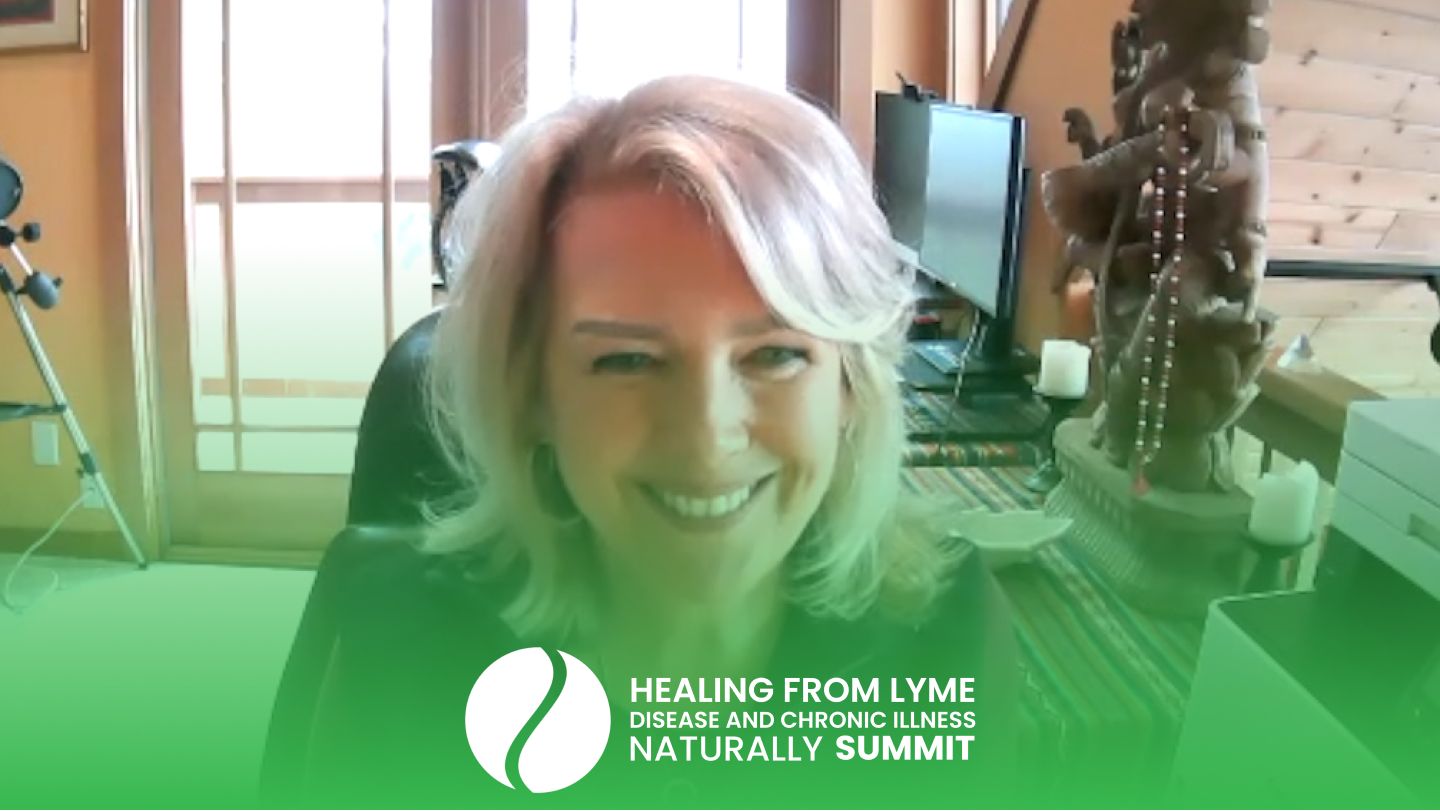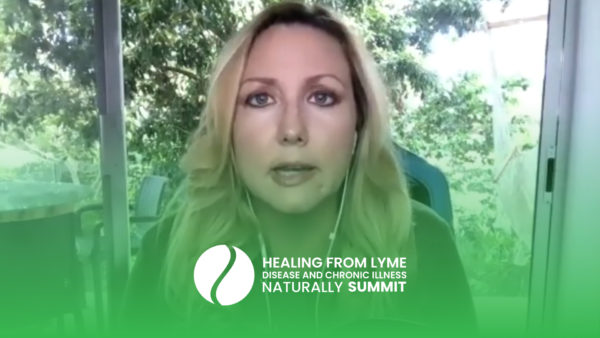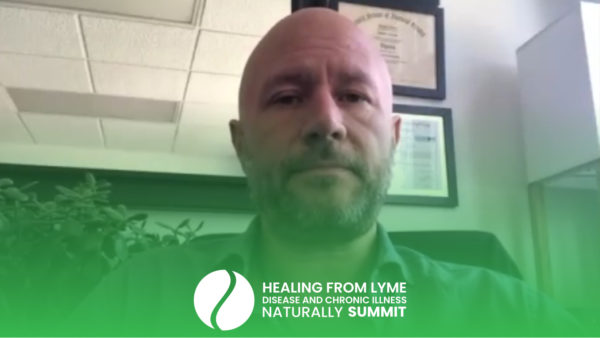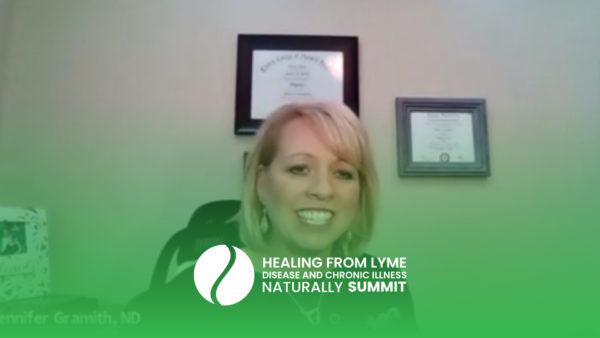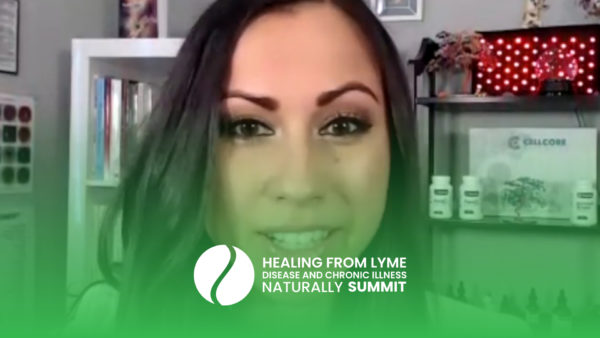Join the discussion below
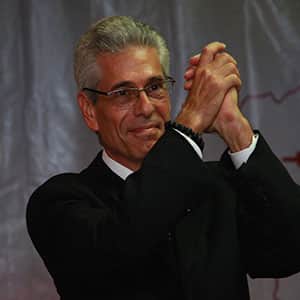
Rob Besner, PSc.D, Co-Founder and Chief Science Officer of Therasage, has always been an advocate of natural health and wellness. Graduating from Boston University in Pre-Med, Engineering, Psychology and Business, he continued onto post graduate work at Case Western Medical School and Holistic Medicine After many years of illness, Mr.... Read More
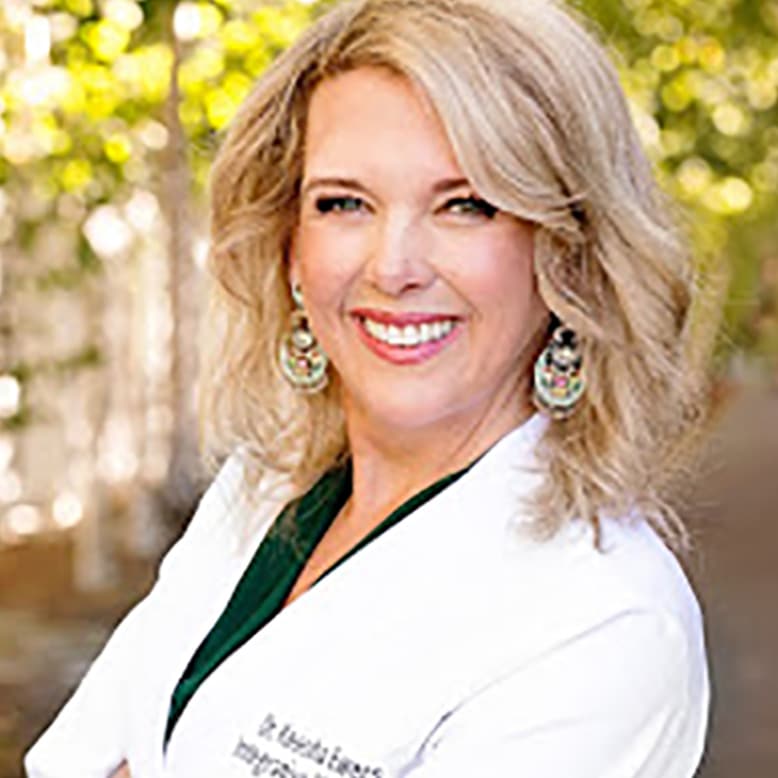
Keesha Ewers, PhD, ARNP-FNP-C, AAP, IFM-C
Dr. Keesha Ewers is an integrative medicine expert, Doctor of Sexology, Family Practice ARNP, Psychotherapist, herbalist, is board certified in functional medicine and Ayurvedic medicine, and is the founder and medical director of the Academy for Integrative Medicine Health Coach Certification Program. Dr. Keesha has been in the medical field... Read More
- Learn to work through past traumas to pave the road to recovery.
- Visit with the expert in managing the associated traumas related to lyme disease and autoimmune disfunction .
- Take 1 step back to taking a GIANT step forward in healing from lyme.
Related Topics
Chronic IllnessRobby Besner PSc.D.
Hey, everybody, welcome back to another amazing interview in the Healing from Lyme Disease Naturally Summit. And today I have Dr. Keesha, and she is amazing. I was reading through her bio. First off, her website is totally cool, but I was reading through her bio, and she’s done so many things that I can’t believe that anybody can achieve that much stuff in such a short time on Earth. So she’s been a keynote speaker. She’s done Ted talks. She’s written books. She has a full practice. And why I feel so passionate about the work that she’s doing is because it’s an area that is, well, I think it’s very underserved. It’s sort of managing the emotional traumas that are associated in our lives. And she has a cool story. I’m hoping that she’ll share some of her backdrop with us today and mostly just to try to highlight how important managing your emotional, your emotions are and how it’s integrated in your overall health and health profile. And so with that, let me bring Dr. Keesha on. Welcome to the summit, Dr. Keesha. Thank you so much for joining us.
Keesha Ewers PhD, MSN, ARNP, FNPc
Oh, it’s my pleasure and honor to be here, thank you.
Robby Besner PSc.D.
So give us a little bit of the backdrop. There’s a reason why you changed the course of your river to get into emotional healing and have made it so much a part of your life and your practice. And what I’ve noticed with people, other people that we’ve interviewed and we’ve had on that oftentimes when they have personal experiences, it seems to change their course, and it makes them a lot more authentic in their own practices and their lives and how they work with other people that may have kind of similar experiences of sort. So if you’d be so kind, grab the audience and let us know a little bit about, you know, how you came to be and what you’re focusing on these days.
Keesha Ewers PhD, MSN, ARNP, FNPc
It’s true, the course of my river has changed a few times in my lifetime. So I started out in medicine as a 19-year-old nurse actually.
Robby Besner PSc.D.
Okay.
Keesha Ewers PhD, MSN, ARNP, FNPc
And for 10 years worked in the high-intensity side of like the balloon pump team, thoracic ICU, those kinds of things, like real high-adrenaline junkie kind of a life. I was raising four children and a marathon runner and just really couldn’t do enough, you know. And then one day, and this is the way my patients always describe it too, and I’m just going to put this as a caveat, it’s not really true, but it’s how it’s experienced, is one day I woke up, woke up overnight sick, you know. And we know that it can take anywhere from 10 to 30 years to get a full-blown autoimmune disease, but I woke up one morning with 10 extra pounds of fluid and puffiness and redness and pain over my joints.
And you know, I was like the Energizer Bunny, according to my friends, and it was as if someone had taken the batteries out of the Energizer Bunny. So I got in to see a doctor, and in the course of the history-taking process, she asked me if I had autoimmunity in my history. And you know, I said, “Yeah, I think my grandfather had it,” you know, and he had actually already died by the time I born. He died at the age I am now, which is 56. So you know, I thought, “I believe he had rheumatoid arthritis and was wheelchair-bound with it.” And she said, “Well, that’s what you have,” and so, you know, “Here are two prescriptions. One’s for methotrexate, and one’s for a strong nonsteroidal anti-inflammatory drug. Come back when you’re worse,” not if, “and we’ll change your meds,” you know? And so I just remember on the way out of her office door going, “Well, just hang on just a second. Like, “I’m really, really disciplined. I make my own food.
I’m a runner. Is there anything besides these medications?” And she said, “No, I’m afraid you’ve kind of joined this elite club and had drawn the short end of the genetic straw.” And so I remember on my way home thinking there had to be a different way of looking at this, that the traditional Western medical framework that I had been trained in and practiced in didn’t have any answers for me. And so I got home and I started looking online for research articles, and in PubMed, I found one on yoga and autoimmune disease and went to my first yoga class the next day. And in the process of that very first class, the teacher, as he’s wandering through the studio and we’re holding our poses, you know, started saying things about Ayurveda, and Ayurvedic medicine is the sister science of yoga.
It’s a 10,000-year-old framework of medicine that comes out of India. And it was intriguing enough that when I got home, I went back on the computer and looked it up, and what I discovered was all those thousands of years ago, they had said that we are not all the same, which is very contrary to the way that we’re taught in Western medicine. You know, we have a disease process with an ICD-9, that’s what it was then, now it’s ICD-10, but an ICD-10 code, and then from there, here’s the list of medications that you can use from here and the labs, right? It’s like a little cookbook of triaging that include meds and labs, and it doesn’t go into individualization. And this was the first time I’d been confronted with that idea. And the other thing that they said was that autoimmune disease is undigested anger.
And I remember, you know, really sitting back in my chair with that one and thinking, “But I’m not an angry person.” And then thinking, “Oh, I’m a people pleaser, a consummate people pleaser, and I wouldn’t allow myself to be angry because it’s a negative emotion and not allowed,” and so I thought that may be a clue. And so in the course of taking these yoga classes, I decided to become a yoga teacher and learn how to meditate. And one day as I was meditating, this word autoimmune was dancing in front of my awareness, and I kept trying to swat it away. And I finally started looking at it, and I thought, “Oh, auto means I’m attacking myself, and so I’m trying to commit suicide basically in a societally acceptable manner” is the way that I really grasped it.
And I thought, “But I don’t wanna die right now, so was there a time in my life that I did?” And that was a really important question for me to ask myself. Instead of how do I get out of this as quickly as possible, what is happening? You know, what is it here to tell me? And so I followed this little question backwards on, I call it like the golden breadcrumb trail of memories, and what I was trying to find was, is there a time in my life when I did wanna die? And I landed on this 10-year-old girl version of myself who was being sexually abused by the vice principal of the elementary school that I was attending. And when I looked at her, I thought, “Oh, she did, she wanted off the planet,” not necessarily to die but just didn’t understand what was going on, had tried to tell a few teachers, had tried to tell my mom.
My dad was out to sea in the Navy, and nothing made any sense to me. And you know, it was a vice principal who says publicly that they’re, you know, it’s a person in authority who’s there to protect children, and then this is happening, and he’s saying it’s ’cause you’re a bad kid, you know? And so nothing made sense to me. And I just remember getting a very strong connection to the angelic realm at that time, you know, like things in the human world aren’t making sense, so I’m gonna make friends with this other dimension and getting very, very keyed in and tuned into that frequency and you know, and just kind of like, “Can you just take me home now? I don’t don’t wanna be here.” And that’s a really interesting pattern that then got set up. I had a couple of near-death experiences through my life.
You know, I think it’s very easy for me to step out of this life now because of that time period. But the other thing that when I landed on that and really witnessed it, I thought, “Oh, she did wanna die,” and maybe my cells took on that programming. And you know, science tells us it can take 20 years to form a full autoimmune illness. So it was as if a turkey timer went off inside of me. It was 20 years, you know, ping, you’re done. Here you go. Here’s your ticket out. And so you know, I thought, “Okay, so this needs to be healed” and went after it with all the veracity of, you know, the energy that I had going towards marathon running and everything else in my life, I went towards this and really healed it up, and my autoimmune disease was gone within six months, and it has never returned.
And you know, the power of the messaging, and I don’t want anyone to hear this and say, “Oh, so you’re saying this is my fault,” right? ‘Cause this is an outside of blame and shame. This is a complete, there are messages that we give subconsciously and unconsciously to our physical system, and Ayurvedic medicine says that we’re more than just our physical body. We have a physical system, but then we also have our energy body and then our emotional and mental and higher consciousness and spiritual layers, so five layers to us. And if we’re toxic in any of them, then we don’t get access to that final one, which is this complete relationship with the divine. And so what I got was, oh, this emotional layer was toxic, and so it was affecting through my energy body to my organ systems and my genetics, how they were going to respond and how they were going to express themselves.
And as soon as I changed that, what was going on there through my energy system, this calmed down that, hmm. So the mind and the body are more than just a trite mind-body-medicine link-up, you know? They really are, they can’t be separated. They’re unified, they’re one. So it was a very big fork in my road and changed the tributaries, definitely the direction of my flow into, okay, instead of working on acute care and hospice, which I really loved, you know, I thought, let’s bring this paradigm of medicine that includes spiritual, emotional, mental, environmental, family, community, and self to the front end of life rather than, you know, like in hospice when we get really good medical care and all that’s included, we have a terminal illness in order to access that. So that’s what it took me back to school for a long time, for that reason.
Robby Besner PSc.D.
Wow, and thank you so much for sharing that. There’s so much emotion that I felt in your story as you were talking. First I felt sad that here’s this young child of 10 whose childhood was affected in a way that at that moment it was sort of life or death, but you don’t have the intellectual and emotional support at that age to understand what all that means, but still those emotions are captured. It makes me feel, and the Lyme people out there listening today can certainly appreciate ’cause oftentimes in our own counseling and our own work in our clinic, we hear, “Why me, why now?” And also, you know, they may have been exposed to Lyme and/or the co-infections, been bitten or influenced somehow 20 years ago, but why did it happen now 20 years later?
Keesha Ewers PhD, MSN, ARNP, FNPc
Right.
Robby Besner PSc.D.
And then there’s often talk about, well, you know, you’ve got all these stressors in your life now, and you know, did you change your job? Did you get divorced? Did you get into a physical, you know, like car accident or something? And that caused, was like the tipping point that actually created that emotional or that way that your immune system was at that point suppressed or compromised, allowing the imbalances of some of these co-infections and the Lyme itself to sort of take over and create havoc on the inside and then you become symptomatic, right?
Keesha Ewers PhD, MSN, ARNP, FNPc
Right.
Robby Besner PSc.D.
So all that stuff is going on, like I always say, I kind of laugh at myself, “Who invented liquid soap and why,” right? There’s all this stuff going on, and you want some clarity or you wanna be able to identify one particular thing, but it isn’t necessarily that.
Keesha Ewers PhD, MSN, ARNP, FNPc
Everyone wants the smoking gun. And you know, this is where that old saying, the bra, the bra, the straw that breaks the camel’s back, right? It happens, and I call it the tipping point or the critical mass is always in place when your boat capsizes. You know, you’ve got a lot of stuff that was already piled up over there, and then the one thing dumps it, but it wasn’t about the one thing, yeah.
Robby Besner PSc.D.
So there’s like a metaphor that I used a lot. It’s mostly relating to me and my family. It’s like, when you go on a trip, let’s say it’s a, whatever, you’re going, leaving town for a little bit. You pack your bag, and then you get to your other location. And then most people, I generally don’t do this, but most people, they unpack their bag, they put their stuff away and all that. And then I thought to myself, well, you know, when you have emotional challenges, you’re basically packing those emotions in your body, right, somewhere. You know, if it’s really, really painful, then it’s usually because the brain doesn’t want you to be in that kind of pain for too long, it would be hard to function. It sort of diminishes the pain and then, but it hasn’t really gone away. It’s just been sort of swept under the carpet. That’s the emotions that are packed in that bag.
Now, if we could, I think a healthier person, when they got to their destination, they would unpack their emotional baggage, leave some room for more emotions to get in there, healthy emotions, one way or the other. My family, what we used to do is we just, when we ran outta a room in the bag, we just bought another bag and bought another bag and bought another bag. So I think we, I know that I’ve studied because I’ve had some feelings about managing your own emotions and what that, how that can express itself, and there’s the Louise Hays foundation or that Louise Hays’s work, she often has really simple books that can trigger or at least direct you towards a certain symptom that you’re expressing and what emotion might be tied to that.
Keesha Ewers PhD, MSN, ARNP, FNPc
Right.
Robby Besner PSc.D.
And I’ve always loved her work because it was just sort of like a coloring book or so simple to read, but it really addressed a very important topic, which you’ve dived really deep into. You did a study in 2013 that you, the acronym is HURT.
Keesha Ewers PhD, MSN, ARNP, FNPc
Right.
Robby Besner PSc.D.
So tell us a little, tell us a little bit about that because I think it’s an important contribution.
Keesha Ewers PhD, MSN, ARNP, FNPc
Well, let me preface it with the largest study that’s been done is the Adverse Childhood Experiences study done by Kaiser Permanente and the CDC, and what they were looking at, Kaiser had a weight loss clinic and people were, it was a good, it was a really good program. People were steadily losing their pounds, but then some people were dropping out before they got there to their goal. And so luckily the clinic director was curious and was asking questions like, so what happened, you know, and found that most of the people that dropped out had been sexually abused in their childhood. And so that triggered the question of, okay, so what’s going on here? And so they joined hands with the CDC and conducted this study that went from 1995 to 1997 of Kaiser Permanente enrollees, over 35,000 participants, I mean, you know, it was a huge study, yeah.
Robby Besner PSc.D.
Love it, okay.
Keesha Ewers PhD, MSN, ARNP, FNPc
And asked, “Before the age of 18, did you experience any of these 10 kinds of trauma?” And we can call these now capital-T trauma, the ones that you think of when you think of trauma. Like my story, sexual abuse is up there, right? Domestic violence, any kind of physical abuse, psychological, spiritual abuse, neglect of some kind, abandonment, having a parent or a caregiver addicted to a substance or incarcerated or mentally ill or dead. These are those big traumas, okay? The more that you check yes to, that becomes an ACE score of 1, 2, 3, right? I have an ACE score of 3. What they found is that in the course of time as you experience these adverse childhood experiences that the higher your ACEs score, the higher the risk is for all of these kinds of chronic illnesses that we see in our culture.
Robby Besner PSc.D.
And I think that’s great.
Keesha Ewers PhD, MSN, ARNP, FNPc
Okay, so Lyme, autoimmunity, cancer, heart disease, also weight issues, behavioral problems, drug addiction, not finishing your education, sexual promiscuity, genetic expressions that go awry, all of those things. And if you have an ACEs score of 6 or more, you are statistically more likely to die 20 years earlier than somebody that doesn’t have an ACEs score. So this doesn’t mean that this is true, like it’s set in stone, right? So in my book “Solving the Autoimmune Puzzle,” I have the ACEs quiz, and I say, okay, so now you have your score, that doesn’t mean you have to be a statistic, okay? And so what I did with the HURT Study, the Healing Un-Resolved Trauma Study, was in 2013, I was kind of looking for why does this come out to be true, right? The more of the ACEs you have, the more likelihood you are to get sick and also not engage in self-care.
That was the most compelling finding for me, less likelihood to engage in self-care of programs in a lasting way. So what I found was, and when I looked at, I only looked, it was a pilot study, 100 women, I asked questions about past hurt, but what I was looking for was how they hold onto it. And from that study came this HURT model, Healing Un-Resolved Trauma model. And in it, you can learn how to track what happened inside your system in response to not just those capital-T traumas but also the lowercase-T traumas. Now, we are biologically wired in our brains to know that if, you know, in tribal we’re put on the outside of the firelight circle from our community, that we can be eaten by the saber-toothed tiger.
So any kind of experience of rejection or betrayal, not feeling good enough, fast enough, fleet enough, you know, like smart enough, beautiful enough, any, you name it, those are those lowercase-T traumas. And every single person, every human has had these experiences, right? So what’ll happen is we don’t have a fully developed brain until we’re 24 to 26 years old in terms of our prefrontal cortex or what’s traditionally called our adult brain, our executive function. So we are operating a lot from our limbic system when young, you know, the amygdala. We’re saying, okay, am I safe? And we’re trying to learn how to become big people in a world governed by big people who are telling us if we’re doing things right or wrong and you know, imparting their value systems onto us.
So when you’re a child, unless you have a well-attuned, well-attached, wise caregiver at your side 24/7 to help you navigate through new experiences that you can’t understand, then you’re going to make stuff up with your child brain, okay, and you’ll make a meaning out of it because you have to. You have to figure out what are the berries that are poisonous and what are the ones that are not, and you know, that’s how we survive as a species. So the way that you do this as a child, and we don’t have a well-attuned, well-attached, wise caregiver with us 24/7, some of us don’t have one at all, right? And so, and as parents, you know, we hope to be that for our children, but we’re not going to be there 24/7.
So every child goes through this process of having a new experience, our first experience as we’re growing up that of some kind that we may not be able to understand, and our meanings that we have attach to it will be fraught with emotions that have to do with fear, anger, terror, you know, sadness, pain, and that then gets embedded in the nervous system, okay, along with the cognitive belief that we create about it. Now, from that belief, we create a behavior pattern that is an adaptive response to whatever just happened at that time in our lives. And so I’m just gonna give an example of how to track this. So for me, if the intercom would go off in the corner of my classroom room in fifth grade, I would go straight into fight, flight, or freeze, you know, and for children, we don’t have power.
We’re not autonomous, and so it’s usually freeze. So I would freeze, and you know, the sexual abuse part didn’t happen that often, but every single time the intercom would crackle to life, I would go into my response. It could be for the Pledge of Allegiance. It could be for the secretary to make an announcement, or it could be to call me to the vice principal’s office. So every time, though, like Pavlov’s dog, I went into my panic. And so that freeze, right, it would freeze into my system. And the meaning I made up was this person, I already kind of said, what I thought, right, that’s in authority can’t be trusted. And so for a child, that means all people in authority can’t be trusted.
And then the belief system is I have to be perfect to even survive this situation. And so my adaptive behavior response becomes perfectionism, which go to 30 years old, I was pretty perfect at doing. I drove myself relentlessly toward perfection. And of course, it’s not a tenable way to live a life, and I guess my system broke down from it. So then in adulthood, just like “The Hero’s Journey” of Joseph Campbell, you get this opportunity to witness something that’s not working that you created when you were a child. So in the HURT model, it has two circles that go below your first initial experience. It’s emotion that you felt, sympathetic nervous system arousal, the meaning you’ve made up, the belief you created, and the adaptive behavior response. Now you get in adulthood an opportunity, over here it says to self-confront, and over here, it says not self-confronting, and then you just keep triggering.
It’s like you have a button that someone can push, and you will go into the rumination of automatic negative thoughts, judgment, whatever it is, it keeps you there, and it will make you sick. Over here, you get an opportunity to self-confront and go, “Oh, maybe the TSA people are not the vice principal.” Maybe your response you have every time you get next to a police officer, you know, is not legitimate. Or when you cross the border from Canada into the United States, maybe you don’t have to go into panic rabbit mode anymore, right? So everyone in authority is not bad. So you get this opportunity to actually question that early belief system and to look at the adaptive behavior as maladaptive now. Oh, perfectionism, that’s really honestly killing you. So then you get this opportunity to unhook all of that.
And there’s a whole process I use for it, but you know, it’s healing your trauma in essence, but it’s also healing, ’cause some people will say to me, “Well, do you have to know what your trauma was?” And I always say, “No,” like the mind unfolds at the rate it’s willing to unfold, and you can reverse engineer this. Is there a maladaptive behavior in your life that’s getting you in trouble? Do you reach for Oreos every time you’re stressed? Do you sit on the couch and binge-watch Netflix when you’re stressed? Do you shop when you’re stressed to the point that you have credit card debt? Like, you know, what are those kinds of, are you drinking too much alcohol? Like, what are the things that are getting in your way? Are you a workaholic? Are you an -aholic of any kind, you know? Then you can reverse that and go into, “Oh, what part of me has decided that that is an adaptive behavioral response when it’s actually hurting me,” okay? So that’s the HURT model.
Robby Besner PSc.D.
Wow, you know, it’s so inspiring. There’s so many things that I’ve heard you just say, and it sort of brought the inner or the little child in me out, you know, what I experienced as a child and the, I just remembered, well, I’m gonna share. So I grew up in New York, and my parents moved from like the Bronx to Long Island. And my grandparents, both sets of grandparents, lived in the Bronx, and every weekend, one set of grandparents would come to our house to visit. And I had two sisters, and we had a couple bedrooms. So my bedroom was always the one that was up for grabs. So whenever a grandparent came, I moved into a common, my sisters’ room or whatever, we had bunk beds in there, and my grandparent took one of, took my room. Well, one time my father’s father had, was staying over and he had a heart attack in my bedroom.
I didn’t understand it. I was probably six or seven years old. And after he left, like within less than a month, and you know, I’m in my 60s, I’m almost 70. And so now we’re going back like age five. It’s 65 years ago or more or less. So I start to having anxiety attacks. Well, 65 years ago, for a six-year-old to have anxiety attacks, they didn’t even know what an anxiety attack was. But I used to say to my mom, “I’m having a heart attack. I’m having a heart attack.” I could hardly say that, but that’s what, how I was articulating it. So I drove my mother crazy, probably that was age-appropriate anyway. And she would drag me to the GP. Like then they had the Marcus Welby-type doctors that were family practices.
And so every other day I was going to Dr. Miller’s office, Dr. Miller’s office, and finally, we had a family member that was my uncle that was also a doctor, and he was up in like kinda Upstate New York. And so we went, my mother took me up to my uncle’s office and said, “George, I don’t care,” in front of me, she said, “I don’t care what you do, but just find out what’s wrong with Robby, and then I’ll come back sometime later.” Well, I didn’t love my uncle George to start with. He wasn’t warm and fuzzy, right? So I was immediately, I’m defensive. I didn’t use those terms then, but I sat, I was a small little guy, and he sat me on this big metal, cold examining table with a guy who didn’t love. And all I felt now as the mature person was that my mother abandoned me. She left me with this guy who I don’t love. And so all of these things were happening. Of course my-
Keesha Ewers PhD, MSN, ARNP, FNPc
‘Cause you were driving her crazy, so you can’t have your sincere, authentic experience of life, or you might get dumped off with Uncle George, yeah.
Robby Besner PSc.D.
Exactly, and so I carry that forward, and it wasn’t until we had another experience in our family that I actually did some sort of timeline analysis to try to trace back, which is part of what you were talking about, where there might have been certain crossroads in my own childhood or my own history, and it’s not always negative things. You think it’s negative stuff, but there are major events, like you get married, you graduate college, you know, or high school, like all of these are events on a timeline. But people that do timeline analysis, and I started to study this, you can see repetitions in patterns, like every three years, something happens, every three years, something happens.
Why is that, you know? So that intrigued me. But so I traced myself back to this event, and it was an exercise, I had to fill out this spreadsheet, and I thought it was gonna be a one-day exercise, and the more I looked at it, it was two days, three days. Then it became a week and a half filling out what I thought was gonna be a one-page turned out to be a thesis of like five or six pages of timeline events. And then I worked with a very beautiful, comforting therapist, and we kind of looked through and analyzed things, and then I tied it back to certain events. So what I found so fascinating about this topic, number one, when we think of trauma, we’re always thinking of these big traumas, you know, the ones that are the headliners.
But when you’re a child, the smallest thing as an adult, what may seem as a small event, to a child that’s a small person, it’s a big event. That’s a big headline, and it still sticks with you. So trauma equals trauma, no matter what age you are. It doesn’t matter, it crosses over age barriers, over economic barriers, like, you know, religion, all that stuff. It’s trauma is trauma, and how we deal with it or process it. But what I love about what you’re saying and what I experienced myself is that all the kinds of healing out there, and I don’t believe that anyone listening today, a Lyme patient that has a chronic challenge, even an acute challenge, that you can’t truly heal unless you manage the emotional part. So even though you’re not necessarily feeling emotional about being trapped in this Lyme circle of frustrating situations-
Keesha Ewers PhD, MSN, ARNP, FNPc
Right.
Robby Besner PSc.D.
You still, it’s still happening, and so you need to think about addressing it. You might wanna consider addressing it. But of all the other kinds of therapies, so we have, you know, medicinal, supplemental, adjustments, physical, and so forth, the ones that, the emotional healing part, once you can kind of figure where the trigger is that you’re stuck and you release that and you’ve articulated it yourself, ’cause you took 20 years to become symptomatic, and then, what, six months or so you said earlier, to sort of unwind that coil and bam, you’re complete again. So emotional healing is, seems to be the most, the quickest one that you can kind of address and get into check. And of course it’s hard to do it yourself. It’s really best when you’re working with somebody like yourself that’s skilled at knowing what questions to ask and direct you towards the areas that you might get stuck and then, well, be stuck and then unravel that part.
And then lo and behold, maybe some of the symptoms that you’re experiencing start to diminish, including bringing your immune system back into a more supportive manner so that you’re actually, your body is positioned in a much more vital way to actually create that imbalance that’s happened in your internal chemistry with all of the different microorganisms, parasites, co-bacterias, you know, co-parasites and so forth. So wow, what an amazing area that you’re in, and I just love how you embraced it and certainly how you’re here today. I mean, you’re not just passive about it. You’re active in your practice. You write books about it. You’ve created programs and profiles and studies about it. And it’s really all for all of us to understand even more importantly how managing your emotional healing process is as important as all the other processes in your healing journey. And I think that it’s, that part is well underserved, right?
Keesha Ewers PhD, MSN, ARNP, FNPc
I call it the missing piece of the puzzle, you know, that we have to address genetics. We have to address gut health. We have to address toxic burden and load, which includes Lyme, but then the trauma piece affects all the other three. So you know, one of my sayings is, “A hypervigilant mind will create a hypervigilant immune system.” So then a tick bite, you know, that carries a bacteria can lie dormant and then all of a sudden, right, sprout, and you harvest the karma of that particular bite, but it’s in this atmosphere of trauma that has made it come up to the surface. And so that’s why physical and emotional trauma both can be triggers for something that happened years and years and years ago, so yeah, definitely, and for your genetics to express themselves in a certain way.
Robby Besner PSc.D.
Cool, well, wow. I’m so happy that you were available to share your experiences with us and certainly your body of work. And time is running out a little bit, so I just want to have you focus with, or tell us like how people can find you, your practice, the books that you’re highlighting, maybe some of the things that you wanna bring to people’s attention now, where they can find you, and so because after this interview, I know that people are gonna be knocking down your door to figure out how they can unwind and find the root emotional causes of maybe some of the areas that they’re stuck.
Keesha Ewers PhD, MSN, ARNP, FNPc
Sure, “Solving the Autoimmune Puzzle” goes through the framework I just mentioned. And my website is drkeesha.com, D-R-K-E-E-S-H-A dot com.
Robby Besner PSc.D.
Okay.
Keesha Ewers PhD, MSN, ARNP, FNPc
And thanks so much for having me.
Robby Besner PSc.D.
Oh my pleasure, and thank you for your contribution and your time, Dr. Ewers. I really appreciate you, Dr. Keesha. Have an awesome day, have a great weekend, and thank you so much for your time today.
Keesha Ewers PhD, MSN, ARNP, FNPc
Bye, everybody.
Robby Besner PSc.D.
Hey everybody, it’s Robby Besner. Thanks so much for joining us today. Please share this content with anyone that you think might benefit from it, and we’re looking forward to having you with us tomorrow for another great interview.
Downloads

